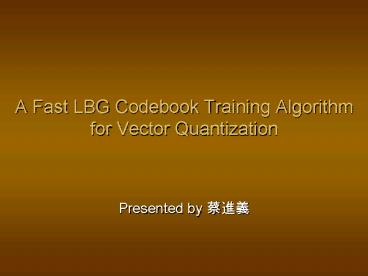A Fast LBG Codebook Training Algorithm for Vector Quantization - PowerPoint PPT Presentation
1 / 32
Title:
A Fast LBG Codebook Training Algorithm for Vector Quantization
Description:
An input vector x = (x1, x2, ..., xk) A codeword yi = (yi1, yi2, ..., yik) ... the property of the training set. FLBG-1a. FLBG-1b. 32 ... The property of image ... – PowerPoint PPT presentation
Number of Views:1763
Avg rating:3.0/5.0
Title: A Fast LBG Codebook Training Algorithm for Vector Quantization
1
A Fast LBG Codebook Training Algorithm for Vector
Quantization
- Presented by ???
2
Motivation
- A fast codebook-training algorithm based on LBG
algorithm. - To reduce the computational cost in the codebook
training processes.
3
Outline
- Introduction
- Previous Works
- Proposed Method
- Some Experiments
- Discussions and Conclusions
4
Image Compression techniques
- Block truncation coding
- Transform coding
- Hybrid coding
- Vector quantization
- Simple structure and low bit rate
5
VQ scheme
- The VQ scheme can be divided into three parts
- Codebook generation
- Encoding procedure
- Decoding procedure
6
Codebook Generation
- The most important task for VQ scheme is to
design a good codebook. - LBG (Linde-Buzo-Gray) algorithm / Lloyd
clustering algorithm - The LBG algorithm is an iterative procedure.
7
Euclidean Distance
- The dimensionality of vector k ( wh)
- An input vector x (x1, x2, , xk)
- A codeword yi (yi1, yi2, , yik)
- The Euclidean distance between x and yi
8
Codebook Generation
9
VQ Codebook Training
- Codebook generation
0 1 . . .
N-1 N
Training Images
Training set
10
VQ Codebook Training
- Codebook generation
0 1 . . .
0 1 . . .
254 255
N-1 N
Initial codebook
Training set
Codebook initiation
11
VQ Encoding Procedure
Image compression technique
w
h
Image
Index table
Vector Quantization Encoder
12
VQ Decoding Procedure
Image compression technique
w
h
Image
Index table
Vector Quantization Decoder
13
Codebook search
- To reduce the computational cost for the
segmentation procedure in the LBG algorithm, many
fast algorithms for codebook search have been
developed. - Partial Distortion Search (PDS)
- Mean-distance-ordered Partial Codebook Search
(MPS) - Integral Projection Mean-sorted Partial Search
(IPMPS)
14
Another fast codebook design
- The tree-structured VQ (TSVQ)
- The k-d tree VQ
15
Outline
- Introduction
- Previous Works
- Proposed Method
- Some Experiments
- Discussions and Conclusions
16
Goal
- To reduce the computation cost in finding the
closest codeword in the codebook. - PDS
- MPS
- IPMPS
17
Partial distortion search (PDS)
- Closest codeword search
- If the minimal distance of each input vector
could not be found early, the PDS method can just
reduce little computation time.
(a0, a1, a2, , a15) input vector
(b0, b1, b3, , b15) codeword
18
Mean-distance-ordered Partial Codebook Search
Algorithm (MPS)
- The Squared Euclidean Distance (SED)
- The Squared Mean Distance (SMD)
- The minimal SED codeword is usually in the
neighborhood of the minimal SMD codeword.
19
Mean-distance-ordered Partial Codebook Search
Algorithm (MPS)
20
Integral Projection Mean-sorted Partial Search
Algorithm (IPMPS)
- Based on multiple distortion measures with
different levels of computational complexity. - Three kinds of integral projections
21
Integral Projection Mean-sorted Partial Search
Algorithm (IPMPS)
- Three distortion measures
Test conditions
For each codeword Yi
22
Outline
- Introduction
- Previous Works
- Proposed Method
- Some Experiments
- Discussions and Conclusions
23
Generalized Integral Projection Model (GIP)
- To reduce the computational cost
- MPS and IPMPS
- IPMPS employs the concept of integral projection
to reject further codeword in search.
24
Generalized Integral Projection Model (GIP)
- Initially, choose one possible projection map of
the pair (p, q). - p segments with q pixels in each segment
- For each input vector, compute the projection
PX(k) of these p segments. - The distortion measure corresponding to this
projection map is defined as
25
Generalized Integral Projection Model (GIP)
- For each codeword, the following inequality can
be easily proven true - The test condition for this projection map can be
constructed.
26
Segment maps
27
Fast LBG Algorithm
- Initially, select a set of test conditions by
repeatedly applying the GIP model with different
projection maps of the desired pair (p, q). - Sort the current codebook by the mean values of
the codewords. - For each vector, find the corresponding closest
codeword.
28
Fast LBG Algorithm
- Record the index of the closest codeword for each
training vector. - Update each codeword
- Overall averaged distortion
29
Outline
- Introduction
- Previous Works
- Proposed Method
- Some Experiments
- Discussions and Conclusions
30
Experiment Methods 512512 image
LBG PDS MPS
31
Experiment Results
the property of the training set
FLBG-1a FLBG-1b
32
Outline
- Introduction
- Previous Works
- Proposed Method
- Some Experiments
- Discussions and Conclusions
33
Conclusions
- A generalized integral projection model is
developed to produce the test conditions for the
speedup of the search process for the VQ codebook
design. - To use these test conditions to eliminate the
need of calculating the squared Euclidean
distance. - The property of image
- By choosing proper sets of test conditions for
different training sets, a great deal of
computation cost can be reduced.































